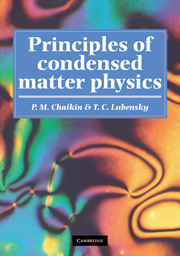Book contents
- Frontmatter
- Contents
- Preface
- 1 Overview
- 2 Structure and scattering
- 3 Thermodynamics and statistical mechanics
- 4 Mean-field theory
- 5 Field theories, critical phenomena, and the renormalization group
- 6 Generalized elasticity
- 7 Dynamics: correlation and response
- 8 Hydrodynamics
- 9 Topological defects
- 10 Walls, kinks and solitons
- Glossary
- Index
7 - Dynamics: correlation and response
Published online by Cambridge University Press: 05 June 2012
- Frontmatter
- Contents
- Preface
- 1 Overview
- 2 Structure and scattering
- 3 Thermodynamics and statistical mechanics
- 4 Mean-field theory
- 5 Field theories, critical phenomena, and the renormalization group
- 6 Generalized elasticity
- 7 Dynamics: correlation and response
- 8 Hydrodynamics
- 9 Topological defects
- 10 Walls, kinks and solitons
- Glossary
- Index
Summary
Much of what we observe in nature is either time- or frequency-dependent. In this chapter, we will introduce language to describe time- and frequency-dependent phenomena in condensed matter systems near thermal equilibrium. We will focus on dynamic correlations and on linear response to time-dependent external fields that are described by time-dependent generalizations of correlation functions and susceptibilities introduced in Chapters 2 and 3. These functions, whose definitions are detailed in Sec. 7.1, contain information about the nature of dynamical modes. To understand how and why, we will consider linear response in damped harmonic oscillators in Sees. 7.2 and 7.3, and in systems whose dynamics are controlled by diffusion in Sec. 7.4. These examples show that complex poles in a complex, frequency-dependent response function determine the frequency and damping of system modes. Furthermore, the imaginary part of this response function is a measure of the rate of dissipation of energy of external forces.
A knowledge of phenomenological equations of motion in the presence of external forces is sufficient to determine dynamical response functions. The calculation of dynamical correlation functions in dissipative systems requires either a detailed treatment of many degrees of freedom or some phenomenological model for how thermal equilibrium is approached. In Sec. 7.5, we follow the latter approach and introduce Langevin theory, in which thermal equilibrium is maintained by interactions with random forces with well prescribed statistical properties. Frequency-dependent correlation functions for a diffusing particle and a damped harmonic oscillator are proportional to the imaginary part of a response function.
- Type
- Chapter
- Information
- Principles of Condensed Matter Physics , pp. 353 - 416Publisher: Cambridge University PressPrint publication year: 1995
- 1
- Cited by



